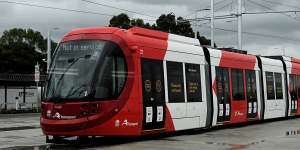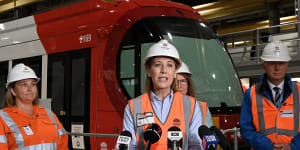Light rail vehicles began moving late at night this week between Dundas,Telopea and Carlingford,the three most northern stops on the stage one section of the project. Testing across the whole line,including in the Parramatta CBD,is set to begin early next year.
Light rail vehicles have begun moving between Dundas,Telopea,and Carlingford,the three most northern stops on Parramatta light rail.
NSW Transport Minister Jo Haylen has promised Parramatta commuters the project would be ready to use by “mid-2024”.
“This testing phase is extensive,” she said. “There are hours of testing to undertake. We want to make sure this is a highly reliable and safe service before passengers are able to get on.”
Construction on a stabling and maintenance facility in Camellia,which will house the vehicles,is almost finished.
Once complete,Parramatta’s light rail system will consist of two lines,similar to the lines that flow through Sydney’s CBD and eastern suburbs.

Testing has begun on a section of the first stage of the Parramatta light rail.Kate Geraghty
The first line runs 12 kilometres between Westmead and Carlingford,via the Parramatta CBD. The second line,once complete,will connect the Parramatta CBD to Sydney Olympic Park,via Ermington and Wentworth Point.
Major construction has finished on the first line. The government earlier this year committed to building stage two of the project,but it refused to give a timeline for it other than that construction would begin during the current term of parliament,which ends in early 2027.
It also refused to announce the costs of the project,but estimated costings from Transport for NSW,supplied to the government,said the second line of the long-delayed project would.
Costs for the first stage of the project last year blew out by $475 million,leading to a total cost of $2.875 billion,putting the cost of both lines at $6.8 billion.

NSW Transport Minister Jo Haylen (centre) announces the start of testing on the Parramatta Light Rail on Thursday.Kate Geraghty
The state government’s September budget committed an additional $200 million for “planning for the procurement,construction,and delivery” of the second stage.
Transport for NSW Coordinator-General Howard Collins said the stage one line would deliver services every 7½ minutes from 7am to 7pm on weekdays.
“We’re going to see a real connection,” he said. “This is bringing rail,ferries,[and] light rail together,and,not long after that,Metro as well.”
The 13 light rail vehicles for the line are the latest generation of Urbos 100 vehicles from Spanish manufacturer CAF. They are battery-powered (for on sections of the line) and are the only light rail vehicles in the city to have bike racks.

But they are not Parramatta’s first trams:the first ones operated between Parramatta and Duck River,which transported locals to a Sydney-bound ferry,from 1883 to 1943.
After testing is complete,one final task:deciding on the lines’ names. The government is yet to announce a decision.
The Morning Edition newsletter is our guide to the day’s most important and interesting stories,analysis and insights..